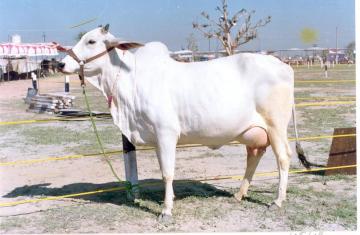Hariana
Hariana is one of the most prominent dual purpose cattle breed of Indo Gangetic plain and named according to the breeding tract of the breed (Haryana state). The breed was earlier known as ‘Hisar’ and ‘Hansi’ according to their place of origin. The breeding tract of the breed includes Hisar, Rohtak, Sonepat, Gurgaon, Jind and Jhajjar districts of Haryana. Typically, the breed is white or light grey coloured with coffin shaped skull. In bulls colour in between fore and hind quarters is relatively dark or dark grey. The animals have long and narrow face, well-marked bony prominence at the centre of poll and small horns. The breed is mainly maintained for bullock production as they are powerful work animals and therefore more attention is paid in managing male calves. However, the cows also produce fair amount of milk. Good cows can produce even up to 1700 kilo grams of milk in a lactation with average cows producing around 997 Kg in a lactation (ranging between 693 to 1745 Kg).
For further details please see the following link
http://14.139.252.116/agris/breed.aspx

Comments
Post a Comment